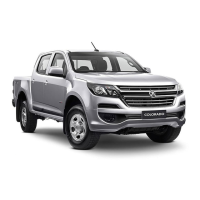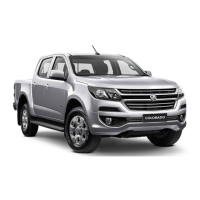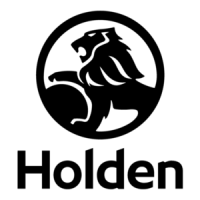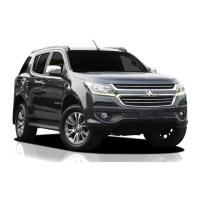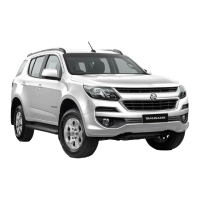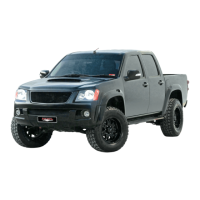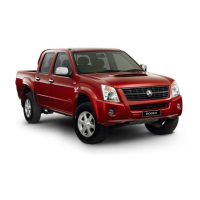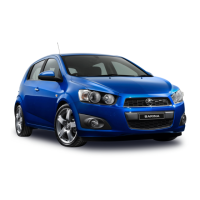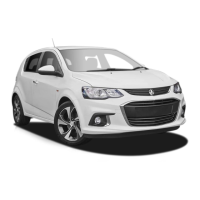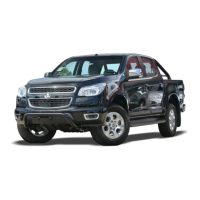
Do you have a question about the HOLDEN RG COLORADO 2014 and is the answer not in the manual?
| Brand | HOLDEN |
|---|---|
| Model | RG COLORADO 2014 |
| Category | Automobile |
| Language | English |
Explains how to navigate the handbook using its structure and index.
Defines symbols and their meanings for critical safety information.
Covers basic vehicle operations like locking and seat adjustment.
Details operation of vehicle keys, remote controls, and locking mechanisms.
Explains manual door locks, door lock snibs, and child security rear door locks.
Covers the anti-theft alarm system and status LED indicators.
Explains manual and power window operation, including auto up/down and anti-pinch functions.
Covers head restraint height adjustment and safety purpose.
Details seat position, adjustment of backrest and head restraint, and safety warnings.
Provides detailed information on seat belt fitting, belt force limiters, and belt tensioners.
Explains airbag deployment, safety precautions, and system components.
Covers child restraint installation, types, and seat belt locking features.
Details instrument panel, glove box, and other storage compartments.
Provides guidelines on safely loading the vehicle and distributing weight.
Details steering wheel adjustment and steering wheel controls for infotainment.
Explains the meaning and function of various warning lights, gauges, and indicators.
Covers personalization settings for the Driver Information Centre (DIC) and infotainment system.
Covers exterior lamp controls, headlamp high/low beam, and headlamp range adjustment.
Details instrument panel illumination and interior lamps like courtesy lamps.
Explains entry lighting, exit lighting, and ticket holders.
Provides general information and an overview of the infotainment system.
Covers operation, display, controls, and features for Infotainment System Type 1.
Covers operation, display, controls, and features for Infotainment System Type 2.
Describes the functions and operation of steering wheel remote controls.
Explains how to adjust the audio system volume using the unit and steering wheel controls.
Details how to adjust audio sound features like bass, treble, balance, and EQ.
Guides on operating the infotainment system, including power on/off and volume control.
Explains tuning, preset saving, and autostore functions for Radio Type 2.
Details connecting and playing music files from iPod® or iPhone® devices.
Explains how to view picture files from a USB storage device on the infotainment screen.
Guides on navigating the USB movie menu, selecting subtitle and audio languages.
Instructions for connecting auxiliary devices and playing music/movies via AUX input.
Explains how to play music and control playback from connected auxiliary devices.
Provides information on playing music via Bluetooth® devices and supported profiles.
Covers personalizing infotainment system settings for Type 2 systems.
Explains how to set the system's time and date format.
Details settings for auto volume, favorites, tune bar, text display, and factory reset.
Manages Bluetooth® settings, including pairing devices, changing PIN, and discoverability.
Allows changing settings like time, date, radio, and language when the vehicle is stationary.
Explains how to select the display language for the infotainment system.
Controls whether text on the audio screen scrolls or displays in a shortened form.
Enables or disables audible beeps when touching the infotainment screen.
Allows adjustment of the maximum limit for the system's initial startup volume.
Displays information about the infotainment system's hardware and software versions.
Information on DivX® video playback and registration for video-on-demand.
Overview of using Bluetooth® phones for hands-free calls and music streaming.
Step-by-step guide for pairing a Bluetooth® phone with the vehicle's infotainment system.
Instructions for pairing a second Bluetooth® device when one is already connected.
Shows how to view connected Bluetooth® devices and their enabled features.
Steps to disconnect a paired Bluetooth® device from the infotainment system.
Instructions for connecting a Bluetooth® device that has previously been paired.
Steps to remove a paired Bluetooth® device from the infotainment system's list.
Covers making calls by entering numbers and using steering wheel controls.
Explains how to switch an active call from the vehicle system to the mobile phone.
Details how to mute or unmute the call microphone.
Describes how to redial the last outgoing or incoming call.
Explains how to accept or reject incoming calls using the system or steering wheel controls.
Guides on navigating and dialing numbers from the phone book.
Instructions on how to search for contacts in the phone book by name.
Detailed steps for searching contacts by entering letters of the name.
Explains how to make calls from the dialed, missed, or received call history.
Describes how to use speed dial numbers stored on the mobile phone.
Steps to install and connect smartphone applications to the infotainment system.
Troubleshooting common error messages when using iPhone® applications.
Troubleshooting common error messages when using Android smartphone applications.
Instructions on how to show or hide application icons in the smartphone link menu.
Guide to using Stitcher™ for internet radio, podcasts, and live stations.
Explains how to rate songs or content using thumbs up and thumbs down features.
Instructions on how to save a preferred radio station.
Details how to pause and resume playback of audio content.
Explains how to skip to the next available station.
Guides on navigating the Stitcher menu to select stations and options.
Guide to using Pandora® for personalized radio stations based on artists, songs, and genres.
Explains how to bookmark artists or songs on Pandora® and where to view them.
Explains how to use the thumbs down feature to skip songs and personalize stations.
Explains how to use the thumbs up feature to personalize station selections.
Details how to pause and resume Pandora® playback.
Explains how to skip to the next station in Pandora®.
Introduces the climate control system, including the air conditioning system.
Explains adjustable and fixed air vents for directing airflow.
Covers air intake maintenance and pollen filter replacement.
Explains operation and caution for the heated rear window feature.
Details how to adjust the fan speed for the climate control system.
Explains how to select air outlets for directing airflow within the cabin.
Details how to adjust the cabin temperature using the rotary switch.
Explains how the air conditioning system cools and dehumidifies air, and notes on saving fuel.
Guides on using maximum cooling for quick passenger compartment cooling.
Explains how to use recirculation mode and its effects on air quality and window misting.
Identifies the controls for the electronic climate control system, including AUTO mode.
Explains how the system automatically selects settings for temperature and airflow.
Explains how to deactivate automatic operation and use manual controls for fan speed and air distribution.
Details how to increase or decrease the fan speed using the display.
Guides on selecting air outlets and operating the cooling system for comfort.
Steps for demisting the windscreen using the climate control system.
Explains how to operate the rear window demister.
Details how to adjust airflow direction and close adjustable air vents.
Instructions for keeping the air intake area clear of debris for optimal performance.
Information on the pollen filter's function and the need for maintenance.
Recommendation for running the cooling system periodically to ensure efficiency.
Covers pre-driving checks like cleaning and tire inflation, and pre-drive procedures.
Provides precautions for new vehicle running-in to ensure optimal performance.
Precautions for turbocharger service life and engine oil management.
Guidelines for checking fluids, driving with awareness, and post-driving checks.
Instructions and warnings for driving through water, including depth limits and brake drying.
Advice on vehicle condition, braking, and gear selection for hilly terrain.
Warnings about securing loose items, especially portable gas cylinders.
Explains the functions of ignition key positions and associated warnings.
Step-by-step guide to starting the engine, including park brake, key positions, and transmission selection.
Information on power outlets that remain active after the engine is turned off.
Guides on parking the vehicle, selecting gears, and locking the steering wheel.
Explains how the selected gear or transmission mode is shown in the Driver Information Centre (DIC).
Describes the functions of P, R, N, and D positions, including manual mode.
Utilizes engine braking by selecting a lower gear when driving downhill.
Assists in maintaining speed on downhill grades using engine and transmission.
Guides on parking the vehicle, selecting gears, and locking the steering wheel.
Explains how to enable manual mode and shift gears using the shift lever.
Covers Kickdown function and fault conditions for the transmission.
Addresses issues with the shift lever and ignition key when power supply is interrupted.
Procedures for releasing the shift lever from park when the power supply is interrupted.
Explains gear engagement, clutch operation, and shift lever usage.
Details the operation and usage of the four-wheel drive system and its modes.
Explains the meaning of indicator lights on the shift control switch.
Describes how to use the switch to select between 2WD High, Neutral, and 4WD High/Low.
Instructions for shifting from 2WD High to 4WD High, including speed limitations.
Instructions for shifting from 4WD High to 2WD High, noting automatic unlocking.
Detailed procedure for engaging Four-Wheel Low, including speed and transmission requirements.
Instructions for shifting from 4WD Low back to 2WD High or 4WD High, including speed requirements.
Procedure for shifting to neutral for towing, including safety warnings and park brake application.
Explains how ABS operation is noticed, pedal pressure, and brake lamp flashing.
Warns about ABS malfunction indications and the vehicle's brake system status.
Guides on applying and releasing the park brake, and associated warnings.
Explains how maximum brake force is automatically applied during forceful pedal application.
Describes how HSA prevents rollback on inclines when moving off.
Explains how TCS improves stability by preventing wheel spin and reducing engine output.
Details the location and operation of the TCS switch, including deactivation and reactivation.
Explains how ESC improves driving stability by managing grip, engine power, and braking.
Describes how to deactivate and reactivate ESC, and its automatic reactivation.
Explains how DCS is activated automatically based on vehicle speed and slope.
Warnings about using DCS only for off-road steep descents and potential damage.
Describes how the system enters protection mode due to prolonged continuous operation.
Procedures for deactivating DCS and how it is reactivated.
Explains how cruise control maintains speed without accelerator pressure and its operating conditions.
Step-by-step guide to setting the desired speed and activating cruise control.
Details how to increase the set speed using RES/+ or SET/- switches.
Guides on decreasing the set speed using the SET/- switch.
Explains how to deactivate cruise control using CANCEL or other methods.
Introduces the Park Assist system and its components for detecting objects when reversing.
Conditions under which the Park Assist system is automatically activated.
Explains the different alarm tones indicating object detection and proximity.
Conditions under which the Park Assist system is automatically deactivated.
Indicates how system faults are signalled and troubleshooting steps.
Important operational notes regarding sensor interference, cleaning, and object recognition.
Introduces the RVC system and its purpose, with safety warnings.
Locates the camera on the rear tailgate and lists objects it cannot display.
Describes the RVC display on the infotainment system and its real-time output.
Steps to activate the RVC system by turning the ignition on and selecting reverse gear.
Instructions for cleaning the camera lens to ensure optimal performance.
Critical safety warning about the dangers of exhaust fumes and the need for system inspection.
Safety precautions during refueling, including switching off the engine and avoiding sparks.
Warning regarding the use of fuel containing ethanol and its potential adverse effects.
Details approved diesel fuel standards, bio-diesel usage, and winter properties.
Cautions on using bio-diesel blends and purchasing fuel from reputable retailers.
Guidelines for filling the fuel tank, managing overflow, and replacing the fuel cap.
Information on the vehicle's fuel tank capacity.
Instructions for unlocking and locking the fuel filler cap on cab chassis models.
Steps for opening and closing the fuel filler door on pickup models.
Explains the meaning of 'trailer' and provides guidelines for towing equipment.
Discusses how towing affects vehicle handling, durability, and economy.
Warns against exceeding towing capacities and the impact on warranty.
Provides towing capacity specifications for 2.5L and 2.8L Diesel models.
Guidelines for tow ball load, trailer balance, and axle load considerations.
Recommends Holden towing equipment and warns about using non-approved accessories.
Lists mandatory equipment for towing loads up to 750 kg and between 750 kg and 3,500 kg.
Advice on tyre inflation, tow ball tightening, vehicle handling, and mirror usage when towing.
States that trailer brakes are mandatory for trailers over 750 kg and advises consulting regulatory bodies.
Recommends running-in a new vehicle for 1,500 km before towing or exceeding 80 km/h.
Advice on reducing speed and load when operating off-road to prevent damage and improve safety.
Notes that more frequent maintenance is needed when the vehicle is used for towing.
Criticality of using Holden approved driving lamps and avoiding obstruction of air intakes.
Importance of using Holden approved roo/nudge bars due to compatibility testing.
Warns that non-approved roo/nudge bars can affect crash, airbag, and engine cooling performance.
Explains how TSC detects and manages trailer sway by reducing engine power and braking.
Instructions for reversing the snorkel intake for snowy conditions or heavy contaminants.
Recommends fitting roo/nudge bars for country areas and warns against urban use due to pedestrian risk.
Advises using only Holden genuine parts and accessories for vehicle care.
Explains the purpose of emission control systems and their contribution to air quality.
Describes major emission control systems: evaporative, crankcase, and exhaust.
States that vehicle engine and exhaust systems must not be modified, and modifications are illegal.
Recommends servicing at specified intervals by an authorised Holden Dealer.
Instructions for storing the vehicle for several months, including washing, fluid checks, and battery disconnection.
Lists checks for power windows, tyre pressures, fluid levels, and engine oil after storage.
General advice on performing service work, with a warning about touching engine components.
Instructions for opening the vehicle bonnet.
Step-by-step guide for safely closing the bonnet, including checks and warnings.
Locates key components like coolant reservoir, brake fluid, and battery in the engine bay.
Locates key components like coolant reservoir, brake fluid, and battery in the engine bay.
Guides on checking engine oil level regularly and before long journeys.
Instructions for adding engine oil, including location of filler cap and dipstick.
Explains how to check and add automatic transmission fluid, with cautions on overfilling.
Notes that the engine air filter is checked during vehicle servicing.
Guides on checking the engine coolant level at least once a week.
Detailed procedure for checking coolant level, with warnings about hot engines.
Instructions for adding coolant, including cautions on spills and approved types.
Ensures power steering fluid level is between MIN and MAX marks.
Instructions for adding power steering fluid, with cautions on contamination and overfilling.
Steps for adding washer fluid and recommended additives.
Guides on checking the brake/clutch fluid level and warns against removing the cap unnecessarily.
Instructions for adding brake fluid, including ignition and cap cleaning procedures.
Warnings about battery hazards, handling, and maintenance-free operation.
Information on battery location and replacement procedures, recommending a Holden Dealer.
Steps for disconnecting the battery when the vehicle is not used for extended periods.
Warning about driving with 'Water in Fuel' indicator illuminated and the need for immediate service.
Procedure for bleeding the diesel fuel system when the tank runs out of fuel.
Guidelines for checking and replacing wiper blades for optimal performance.
Advice on replacing bulbs, including turning off ignition, using specified wattage, and handling.
Lists specific bulbs that should be changed by a Holden Dealer.
Instructions for removing protective covers and replacing low beam headlamp bulbs.
Step-by-step guide for replacing the high beam headlamp bulb.
Instructions for replacing headlamp bulbs from within the engine compartment for Type B.
Steps for disengaging bulb holder, removing bulb, and replacing it.
Steps for unscrewing fasteners and removing the tail lamp assembly.
Identifies the tail/brake lamp component.
Identifies the turn signal lamp component.
Identifies the reverse lamp component.
Steps for unscrewing fasteners and removing the centre high-mounted brake lamp assembly.
Instructions for replacing the bulb in the number plate lamp.
Locates fuse boxes in the engine compartment and on the driver side.
Warnings and guidelines for changing fuses, including turning off ignition and using correct amperage.
Explains the location and use of the fuse extractor tool.
Locates the fuse box in the engine compartment and how to disengage its cover.
Locates the fuse box in a storage compartment on the driver side of the instrument panel.
Details the location and removal of the vehicle jack and associated tools.
Advises on avoiding tyre/rim damage and checking for damage.
Emphasizes checking tyre pressure regularly for safety, fuel efficiency, and tyre life.
Guidance on selecting new tyres based on vehicle placard and potential effects of size variations.
Warns about using incorrect wheel covers and their potential to cause damage or injury.
Specifies fitting tyre chains only on rear wheels and removing hub caps.
Explains where to find correct tyre pressures and load ratings.
Guides on checking tread depth and when to replace or swap tyres.
Critical safety warnings for jacking the vehicle and handling wheels.
Usage limitations and warnings for tyre chains, including speed and link thickness.
Detailed steps for safely changing a vehicle tyre, including jacking and wheel nut procedures.
Detailed steps for removing wheel nuts using the wheel wrench.
Guides on positioning the jack correctly for front and rear tyre changes.
Critical safety warnings about battery hazards, explosive gases, and electrical current.
Step-by-step guide for jump starting a vehicle with a flat battery using jumper leads.
Recommends flat-bed tow trucks to avoid damage and provides warnings for towed vehicles.
Guidelines for emergency towing on hard surfaces at low speeds, including enabling steering lock.
Important notes for towing, including driver presence, speed, power assist, exhaust fumes, and vehicle condition.
Instructions for recovering the vehicle using front towing eyes, with load capacity cautions.
Advice on regular washing and waxing, and cleaning contaminants to prevent paint damage.
Cautions against using abrasive cleaners or solvents on plastic exterior lamp covers.
Instructions for clearing debris from air intakes during washing.
Guidance on waxing vehicle paintwork and using polish for protective films.
Advice on cleaning glass, using washer additive, and inspecting wiper blades.
Cautions against high-pressure cleaners, petrol, and abrasive cleaners for wheels and tyres.
How to rectify minor paintwork damage and have extensive damage repaired.
Instructions for washing the underbody to prevent rust, especially after winter exposure.
Warnings about toxic cleaning products and recommendations for water-based cleaners.
Guides on cleaning the vehicle interior, instrument panel, fabric upholstery, and seat belts.
Advice on cleaning plastic and rubber parts with interior cleaner, avoiding solvents.
Ensures floor mats are securely fastened to prevent movement.
Emphasizes importance of maintenance work at proper intervals for economical and safe operation.
Lists recommended fluids, lubricants, and parts for the vehicle.
Explains the vehicle's computer system that indicates when to change engine oil and filter.
Lists specifications for engine oil, coolant, transmission fluids, brake fluid, and battery.
Explains the location of the Vehicle Identification Number (VIN) and the identification label.
Details the information found on the identification label on the front driver’s door frame.
Indicates the location of the engine serial number on the engine block.
Provides engine type, number of cylinders, engine power, torque, and diesel fuel specifications.
Specifies maximum front and rear axle loads and refers to the gross vehicle mass (GVM).
Defines carrying capacity as the maximum load for non-standard items, cargo, occupants, and equipment.
Provides design dimensions for length, width, height, track, overhang, and wheelbase across different cab/pickup configurations.
Lists capacities for engine oil, coolant, and fuel tank for different engine types.
Details recommended tyre pressures for normal and maximum load conditions, including spare tyre.
Outlines the process for addressing concerns with sales, service, and dealer management.
Provides contact information for Holden Customer Care offices in Australia.
Lists essential information to include when contacting customer care via letter.
Notes potential differences in warranty and assistance provisions for New Zealand.
Information about DivX® video format and DivX® Certified devices.
